A breeze whistled through the rigging, and spots of rain on the windows betrayed rain. The marina looked deserted apart from solitary souls walking their dogs along the pontoons and paths around the marina.
With a mouth like a gorilla's armpit after the whiskey infusion Meryl had given me, I went off to the shower block, performed the usual rituals, and spent an age in the shower; great when it's free.
I cooked us all omelettes for breakfast, pointing out the direction of the toilets to my shipmates. The last time I cooked them an omelette in Leeuwarden, they kindly waded through it, and then without fuss quickly sprinted to the toilets. Not a word was mentioned; very sweet and considerate I thought. Today they felt no need to dash to the toilets. In fact the number of eggs I had given them would bind them up for a week.

Rex Helming up the Grevelingenmeer Amongst Elegant Craft
|
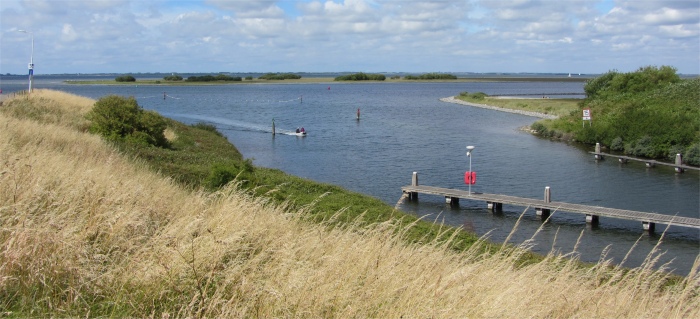
Intricate Entrance to Brouwershaven Harbour, Dwars in den Weg Island in the Background
|
By mid-morning we were sailing on the Grevelingenmeer. This large stretch of water was a former Rhine-Maas estuary, bordered on the north side of the lake by the South Holland island of Goeree-Overflakkee and on the south by the Zeeland Schouwen-Duiveland. In 1965, the Grevelingendam was constructed on the east side. When the Brouwersdam was built to block off the North Sea in 1971, as part of the Deltaworks project, Grevelingenmeer was created. Grevelingenmeer had an area of 11,000 hectares, excluding the dried portions which were 3,000 hectares in size. Thus it was the largest saltwater lake in Western Europe. Water management employing the east and west dams ensured the hinterland was never in danger. Apart from fishing and the oyster and mussel beds, the lake was mainly used for recreational purposes, with no commercial traffic.
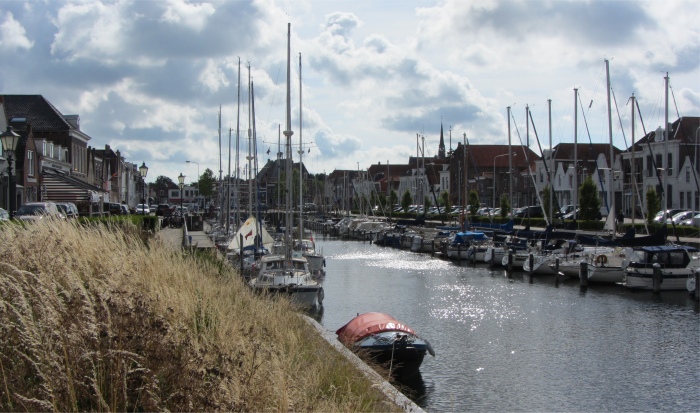
Looking Up the Harbour Towards the Market
|
As usual, the wind was on the nose, so we tacked most of the way. As we sailed up towards Veermansplaat (ferryman's place) island, an armada of yachts were heading downwind towards Bruinisse, so canny manoeuvres were necessary to avoid them. We also spotted a British yacht heading up the lake too, the kind owner giving way to us as we tacked. Through a few shouts as we passed each other, we learned that the owner was from Ipswich, and he was heading towards Brouwershaven, our destination too. Instead of taking a shortcut to the port through the Geul van Bommenede (Bommenede trench), we headed up towards Hompelvoet island, and then circled around to Rede Brouwershaven, a narrow channel between Stampersplaat (pushers place) and Dwars in den Weg (cross in the road) islands. A couple of hairpin bends brought us through a narrow channel and a lock into Brouwershaven harbour, where we tied up on the south side wall.

Impromptu Conga After the Netherlands Beat Mexico
|
We had sailed solidly for over five hours, the wind occasionally gusting and shifting. Other water craft had added a welcome challenge to the passage. The sun shone brightly on us now, and it had been a truly exhilarating sail. Meryl had a different take on that, she can't handle the boat heeling right over.
After checking in with the harbour master, we pulled alongside a berth in the centre of town itself. The Ipswich chap we had seen earlier helped with our ropes. It turned out that his boat was actually one of three boats that had set off from the Ipswich/Felixstowe area. In a short time all three boats were tied up together. Later we were to notice that this particular quay we were moored alongside was where the harbour master directed the British.
Once we were sorted out we climbed up to street level to seek food and liquid. Tonight the Netherlands were playing Mexico, so there could be difficulties. The "'t Swarte Schaep" (Black Ship) nearby was standing room only, and not being dressed in orange, we would have stood out a mile.
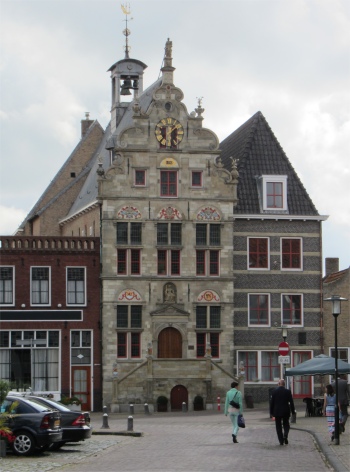
Stadhuis
|
Crossing the market square, we found a restaurant that was not awash with orange people, in fact it had no customers, but it was showing the football match. Once inside we realised it was a Chinese restaurant, but that didn't matter. We were spoiled for choice regarding table selection, so we chose one in front of the large flat screen that was casting an orange and green glow over the surrounding area. The table between us and the screen was occupied by what I assumed was the owner, a woman I took to be his wife, and another woman who seemed to be the manager.
The menu was in Dutch and German. That didn't seem to pose a problem though, the staff seemed fluent in these languages plus English.
Soon we were tucking into a very tasty and plentiful selection of food, and it was a delight to not be confronted with bowls brimming with frites.
The manager and his staff were extremely vocal over the football match. I would never have expected the Chinese to be so exuberant over this sport, but this group were going bananas. We had no idea what they were saying though, even Rex's linguistic skills stop short of Chinese. At one point in the game Rex said of one of the Dutch players, "He was a lucky boy." From that moment on, the manager would occasionally interject his animated Chinese commentary with, "He was a lucky boy," in English.
The Netherlands were indeed lucky and won 2:1. A Dutch chap, who had arrived during the game to collect a take-away, picked up his food, and with a sigh of relief muttered, "We were lucky," and set off home. Almost as soon as the game ended, hordes of school children dressed in orange ran up and down the street whooping and screaming with delight. Then an impromptu small procession entered the square, a solitary drummer followed by more and more hangers-on, all performing a primitive conga.

St. Nicholas Church
|
We needed to walk off our food, so a short walk around town was in order. This neat, clean well-kept town had an interesting history like so many of the other towns we had visited. The town was founded around 1258 as a new port for Brijdorp, a village whose harbour had silted up. The name Brouwerschavensche first appeared in 1318, and it received city rights from Albrecht of Bavaria in 1403. Initially Brouwerschavensche's existence was linked with the water, with fish and shellfish being an important source of income. But the trade in wine and beer (hence the name Brouwershavensche), wood, stone, wool, flax, turnips and beets helped the city to grow. For a long time the extraction of salt by burning peat that had been flooded by the sea was a source of income, but when this was banned, they imported salt from warmer climes such as Portugal. This was transported to Baltic ports and traded for wood products.
Brouwershaven became embroiled in the Hoekse en Kabeljauwse (Hook and Cod) wars, a series of wars and battles in the County of Holland between 1350 and 1490, over control of the Low Countries. The Battle of Brouwershaven was fought on January 13th 1426 in Brouwershaven.
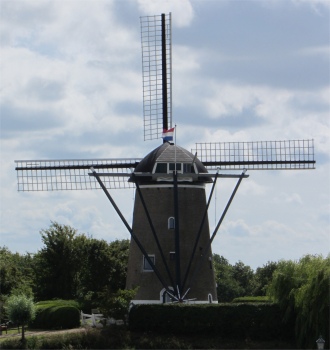
Den Haan
|
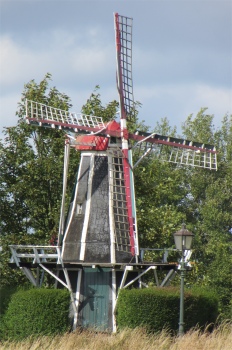
Windlust
|
The origins of the conflict lay in a succession dispute between Jacqueline of Hainaut and John III, Duke of Bavaria over the Counties of Hainaut, Holland and Zeeland following the death of Count William VI in 1417. As leader of the Hooks, she drew most of her support from the petty nobility and small towns. Her opponents, the Cods, were drawn largely from the burghers of the cities, including Rotterdam and Dordrecht. Jaqueline requested support from her husband Humphrey, who was in England, and he set about raising a force of 1500 English troops to reinforce her, led by Walter FitzWalter, 7th Baron FitzWalter. The Duke of Burgundy personally led the Burgundian army that landed at Brouwershaven, consisting of his own feudal retainers and municipal militia from Dordrecht, The Hague, and Delft. The force consisted of about 4000 combatants, including gunners from Dordrecht and over 1000 militia crossbowmen. The Zeelanders, led by the Lord of Heemstede, numbered about 3000 men, reinforced by the English, who were reduced to about 1200 men. However, when the Burgundians were still disembarking, the English led an attack, advancing in good order, giving a great shout and blowing trumpets. The English troops were bombarded with a cannonade and a volley of arbalest bolts from the militia. The well-disciplined English longbow men held firm and then shot back with their longbows, quickly scattering the crossbowmen in disarray. The well-armoured and equally disciplined Burgundian knights then advanced and came to grips with the English men-at-arms. Unable to withstand the fierce attack of the knights, the English men-at-arms and archers were driven onto a dike and were virtually wiped out. This resulted in a significant victory for Philip the Good, Duke of Burgundy. The loss was devastating to Jacqueline's cause, and she was eventually compelled to surrender the administration of her territories to Philip.
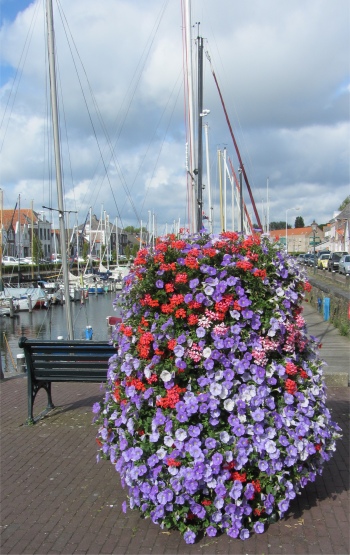
Flower Pots Everywhere
|
During the Eighty Years' War, in 1575 the little fortified town was captured by Spanish troops and then set on fire. From 1590 Brouwershaven was provided with earthen ramparts, surrounded by a wet moat. Five gates gave access to the city. An attempt in 1619-1620 to get a seat in the States of Zeeland failed because of opposition by First Noble Prince Maurits and Delegated Councils, so Brouwershaven always remained a small town. During the flood of 1682 a part of the fortifications were destroyed. The fortress was abolished in 1820, after which it was decommissioned. The ramparts and ditches on the east and north side of the city had been preserved.
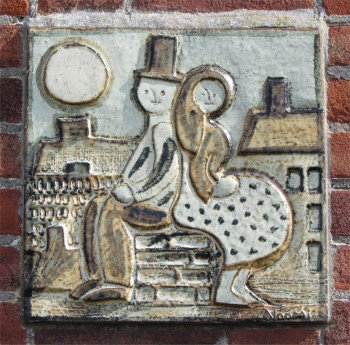
Cool Simple Plaque
|
Times of prosperity and adversity waxed and waned in the town. Brouwershaven had one flaw: access from the port to the Grevelingenmeer was long and narrow, larger commercial ships could no longer enter the harbour, and Brouwershaven went into decline.
On the market square stood a statue of Jacob Cats, created by sculptor G. Parmentier who hailed from Ghent. It was unveiled in 1829. Why? He was born here of course, and went on to become a poet, moral writer and statesman. By all accounts he was an interesting character. In 1621, on the expiration of the twelve-year truce with Spain, the breaking of the dykes drove him from his farm. He was made pensionary (stipendiary magistrate) of Middelburg; and two years afterwards of Dordrecht. In 1627 Cats came to England on a mission to Charles I, who made him a knight. In 1636 he was made Grand Pensionary of Holland, and in 1648 keeper of the great seal. In 1651 he resigned his offices, but in 1657 he was sent a second time to England on what proved to be an unsuccessful mission to Oliver Cromwell. He got around a bit, then.
At the end of the market furthest from the harbour stood the Stadhuis which comprised two parts. The oldest part, facing the dyke was extended in 1599 with a part on the market side. A saunter down Korenmarkt brought us to Kerkpad which ran alongside St. Nicholas Church, whose construction began around 1325. The church was extended to a three-nave hall church in the mid-16th century and took on its final shape. Similar to Veere Grote Kerk, a few large windows were bricked up. I wondered if this was for the same reasons as at Veere; strong winds kept caving them in.
Two windmills proudly stood guard on the ramparts, the flour mill De Haan 1724, and the small but functional mill Windlust 1935.
As to be expected, the town was full of well-kept houses, brightened up with huge flower displays, and no part being far from the countryside.










